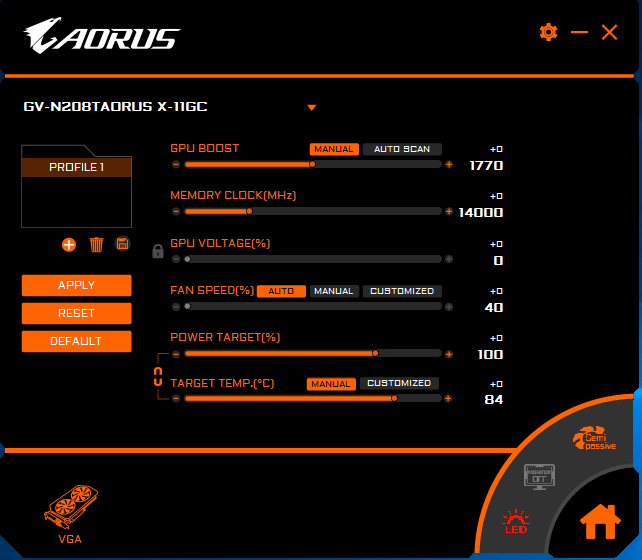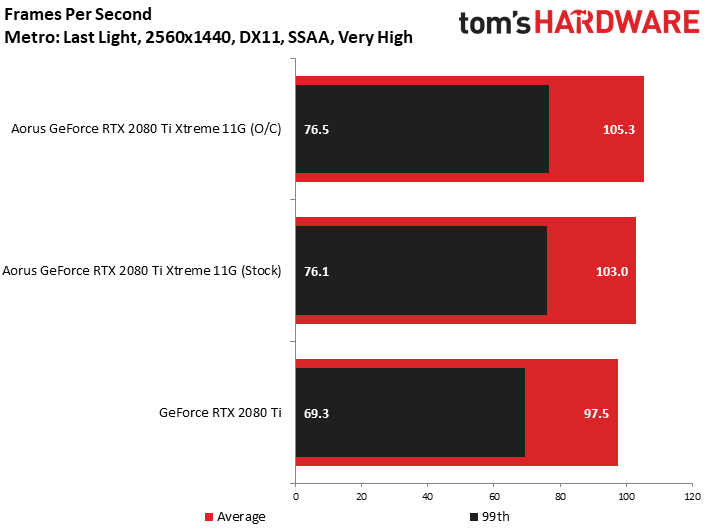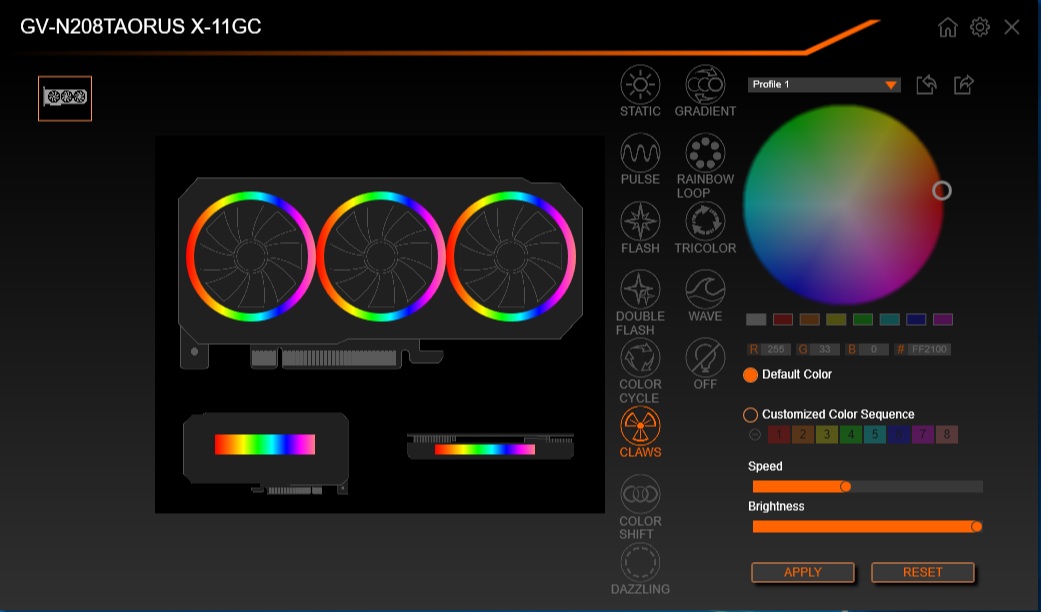Aorus GeForce RTX 2080 Ti Xtreme 11G Review: In A League of its Own
Why you can trust Tom's Hardware
Software and Overclocking
Gigabyte bundles the Aorus GeForce RTX 2080 Ti Xtreme 11G with its own utility for overclocking and fan control. The latest version of this software, called Aorus Engine, was 1.50 at the time of writing.
Unlike some of the lower-end cards, this flagship-class model didn’t present us with a simple interface for toggling between OC, Gaming, and Silent modes. Instead, we were ushered directly into Aorus Engine’s Professional mode with access to GPU Boost control, a memory clock rate slider, GPU voltage adjustments, a manual fan speed dial, and linked power target/temperature target sliders. Maybe that’s because Gigabyte doesn’t specify any mode beyond the Xtreme card’s 1,770 MHz default core clock rate.
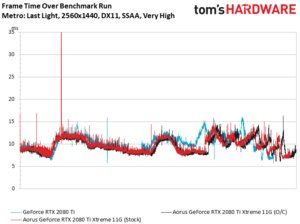
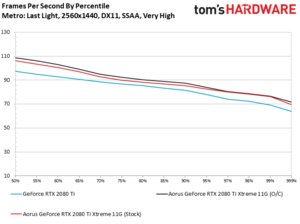
The Professional mode provides access to an Auto Scan button that leverages Nvidia Scanner functionality to tune the voltage/frequency curve. Although the feature completed its scan on our test bed, it didn’t seem to make any changes to the Aorus GeForce RTX 2080 Ti Xtreme 11G’s GPU Boost frequency. So, we fired up EVGA's Precision X1 tool and scored a +112 after increasing the power target/temperature limit. The resulting performance was about 2 percent higher through our Metro: Last Light benchmark at 2560 x 1440, and 8 percent higher compared to Nvidia’s Founders Edition card. This is the approach we recommend taking for overclocking Turing-based cards.
We also took some time to play with Gigabyte’s new RGB Fusion 2.0 app, which looks a lot like the previous version of RGB Fusion but adds the ability to control compatible hardware devices from a single interface. Clearly, Gigabyte is going after Asus’ Aura Sync ecosystem with this latest release.
MORE: Best Graphics Cards
MORE: Desktop GPU Performance Hierarchy Table
MORE: All Graphics Content
Get Tom's Hardware's best news and in-depth reviews, straight to your inbox.
-
NinjaNerd56 I’ll keep the GTX1060 machine I have....that cost IN TOTAL 1/2 of what this card goes for...and ray trace around all the money I have left.Reply -
tomspown The price stated of vega 56 and 64 are there to make the price of the 2080ti less wow but the real price of vega 56 is 370 euro and the vega 64 449 euro. i realy hate it when Toms H. uses over blown prices on AMD products just to make the competition a good buy.Reply -
jimmysmitty Reply21631806 said:The price stated of vega 56 and 64 are there to make the price of the 2080ti less wow but the real price of vega 56 is 370 euro and the vega 64 449 euro. i realy hate it when Toms H. uses over blown prices on AMD products just to make the competition a good buy.
I am not sure where they get their pricing but they did the same with the RX590 review with a over priced 1060. I think its a site algorithm that pulls prices and not a person as any normal person can easily find better deals. -
delaro I would think Nvidia would have learned a lesson on overly pricing cards with gimmicky tags... well I guess not and no wonder their stock tanked. I wouldn't think it's all that hard to understand, Selling 20,000 cards @ $1300+ or 250,000 @ $200? Over the last 15 years what range of cards have sold the most and which one gets released last in line? Splatting a big RTX label and charging a premium on a GPU when software is still 12 months behind was just stupid and we can add it to the many other gimmicks Nvidia has come up with over the years that failed to draw sales " PhysX, Early stages of VR, Hairworks, and now RTX" These cards are indeed nice but adding that extra premium just for "RTX" is just bad marketing.Reply -
redgarl How can a card with such a bad value proposition could score that high?Reply
It is insane, that you guys, are now accepting Nvidia price gouging behavior as something normal.... IT IS NOT!
This card offer the worst value ever. -
ingtar33 obviously a paid ad in the form of a review. for shame THGReply
About ready to retire this site for good at this point; first "just buy it because there is a price to NOT be an early adapter tripe", then a 4.5/5.0 for any NVIDIA RTX product is just a slap in the face of the site readers.
Clearly this is about the ad bucks, not sure how your reviewers can look themselves in the mirror anymore. -
cosmin.matei86 Any1 with a 1070ti or above is absolutely fine at 1440p resolution. My card scores about 60 fps in the last tomb raider and 52 in AC Oddysey benchmark. In game with dips to just unde 40. Coupled with a high refresh g sync monitor I don't even notice low framerate.Reply
I'll say pass to shitty rtx. I cannot believe how people could pay 1300 for a gimmick like rays. Gimmick that you will find in 0.0001% of the time played in the 2 existing games. It's like getting the gold frame. I would have preferred they invested in better more advanced phisics and market that. -
Phaaze88 Reply21632900 said:Any1 with a 1070ti or above is absolutely fine at 1440p resolution. My card scores about 60 fps in the last tomb raider and 52 in AC Oddysey benchmark. In game with dips to just unde 40. Coupled with a high refresh g sync monitor I don't even notice low framerate.
I'll say pass to shitty rtx. I cannot believe how people could pay 1300 for a gimmick like rays. Gimmick that you will find in 0.0001% of the time played in the 2 existing games. It's like getting the gold frame. I would have preferred they invested in better more advanced phisics and market that.
Not to mention, the current gen of RTX is only optimized for 1080p!
RTX Off: too powerful for 1080p. Ideal for 1440 and 4k
RTX On: Works best at 1080p. But for 1440 and 4k? NOPE.
The core feature of these cards(flagship) is useless to folks with higher res monitors, while being too powerful without said feature for those on lower res ones. This is why I'm passing on this gen's flagship.
It's just a bad investment all around.
And the 2060 won't fix this either:
RTX Off: great for 1080p.
RTX On: Not going to be able to run max settings like the 2070(?) and up, but hey, the overall build will be better balanced at least?
If they can keep the RTX train running, I'll hop aboard when they can do RTX On: 1440p, 100+hz. -
delaro Reply21632957 said:21632900 said:Any1 with a 1070ti or above is absolutely fine at 1440p resolution. My card scores about 60 fps in the last tomb raider and 52 in AC Oddysey benchmark. In game with dips to just unde 40. Coupled with a high refresh g sync monitor I don't even notice low framerate.
I'll say pass to shitty rtx. I cannot believe how people could pay 1300 for a gimmick like rays. Gimmick that you will find in 0.0001% of the time played in the 2 existing games. It's like getting the gold frame. I would have preferred they invested in better more advanced phisics and market that.
Not to mention, the current gen of RTX is only optimized for 1080p!
RTX Off: too powerful for 1080p. Ideal for 1440 and 4k
RTX On: Works best at 1080p. But for 1440 and 4k? NOPE.
The core feature of these cards(flagship) is useless to folks with higher res monitors, while being too powerful without said feature for those on lower res ones. This is why I'm passing on this gen's flagship.
It's just a bad investment all around.
And the 2060 won't fix this either:
RTX Off: great for 1080p.
RTX On: Not going to be able to run max settings like the 2070(?) and up, but hey, the overall build will be better balanced at least?
If they can keep the RTX train running, I'll hop aboard when they can do RTX On: 1440p, 100+hz.
It's not that the hardware isn't powerful enough.. It's that the API's are a year behind being able to render it without massive performance issues. So yes it makes these premium cards now seem Gimmicky and over inflated in price.
In a way they are listening by releasing Touring cards without the RTX badge at a closer to normal price. The issue here is the market is flooded and Nvidia is going to rush out Touring with 2X the badge numbers they normally release. Glad I moved all my Nvidia stock to AMD when Ryzen launched.
-
lorfa "this is an extremely heavy card to hang from a PCIe slot, so Gigabyte bundles a stand meant to support the card by pushing up from your bottom-mounted PSU or the floor of your chassis."Reply
This made me lol, what a time we are in.
